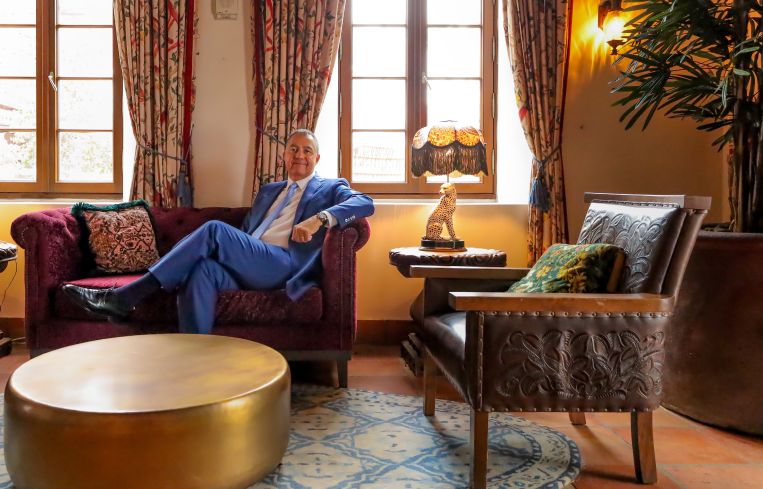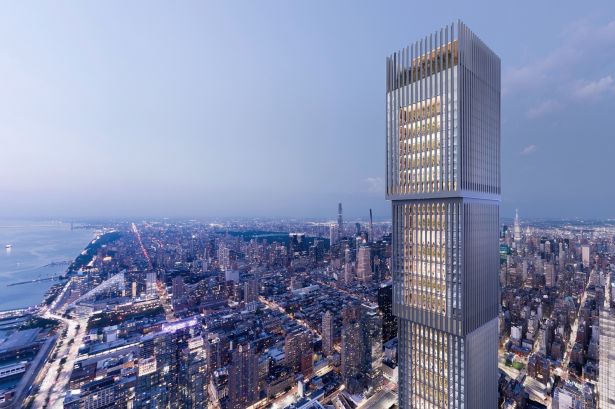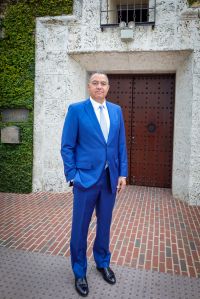Don Peebles Hopes to Build the Most Inclusive Skyscraper in Manhattan
Developer Don Peebles has a dream to pull off a 2 million-square-foot, mixed-use giant across from the Javits Center that he says will be the most inclusive skyscraper in U.S. history
By Cathy Cunningham March 21, 2022 11:57 am
reprints
On the West Side of Manhattan, just across from the Jacob K. Javits Convention Center, sits a 1.2-acre site. A piece of land of that size is like gold dust in Manhattan — and Don Peebles has big plans for it.
And he has named it Affirmation Tower. A development team comprised of Peebles’ Peebles Corporation; Cheryl McKissack Daniel, president and CEO of McKissack & McKissack; Craig Livingston, managing partner of Exact Capital; and Steven Witkoff, chairman and CEO of Witkoff, have proposed a 2 million-square-foot mixed-use development for the vacant site.
The state-owned land at 418 11th Avenue at West Street isn’t theirs yet, though.
The original request for proposals (RFP) for the site was issued by then-Gov. Andrew Cuomo’s administration in March 2021, with firms including Brookfield, Related Companies, Rockrose Development Corp. and Tishman Speyer all reportedly submitting plans for the site. When Gov. Kathy Hochul succeeded Cuomo, her administration shelved the original RFP, deciding to realign the request more closely with Hochul’s priorities and solicit feedback from the surrounding community. Part of that review included the potential inclusion of affordable housing at the site.
Hochul and the Empire State Development Corp. have not set a release date for the new RFP, although Peebles expects it soon, and his confidence in Affirmation Tower being the winning proposal is unwavering. If they win the RFP, its development team aims to create a civic landmark, and the most inclusive building in New York City, at the site.

Affirmation Tower’s genesis already encompasses a roster of firsts. If given the green light by state officials, Affirmation Tower would be the world’s tallest building owned by majority Black-owned companies, the tallest building ever built by a woman-led contractor, and the world’s tallest skyscraper designed by a Black architect.
Reaching 1,633 feet, it would be the tallest building by floor height in the Western Hemisphere, but technically the second-tallest building in New York City (this was an intentional decision to keep its spire shorter than 1 World Trade Center’s out of respect for what 1 WTC represents) and include office space, two hotels and an open, inviting aesthetic with public community spaces available to New Yorkers and tourists alike. An observation deck at the top would include an event venue and a skating rink.
The NAACP, the country’s longest-standing civil liberties organization, has already committed to occupying 24,000 square feet, which would serve as the organization’s New York headquarters.
The developers’ plans are set, although the site’s RFP process is ongoing.
Just as Peebles’ conviction in his plans for Affirmation Tower is steadfast, so is his belief that affordable housing isn’t a good fit for the site, although that’s what Hochul is reportedly exploring.
“Obviously, affordable housing is a sensitive issue and an important issue,” Peebles said last week. “But it doesn’t belong across the street from one of the largest convention centers in the United States — a tourism and economic engine for New York. My understanding is that there’s going to be a new RFP that will be coming out shortly, and we’ll go from there. I feel as committed to the project and its concept as I did before. I think it’s a project whose time has come.”
The museum
Deepening the project’s significance as an ode to Black culture, Affirmation Tower is also now slated to be the location of New York’s first civil rights museum, the Museum of Civil Rights, led by the Rev. Al Sharpton and previously planned as part of a development in Harlem.
“We are fortunate enough to now have the rights to develop the museum,” Peebles said. “We’ll have it [at Affirmation Tower], which, frankly, is much more accessible to a larger number of visitors from around the world who come to New York and are in Midtown West. Javits Center alone draws tens of millions of people a year. We think that this is the appropriate place for it, and, given that we have the NAACP offices in the building as well, it’ll be a wonderful opportunity for visitors to access the museum.”

Peebles went on to note that the National Museum of African American History and Culture (NMAAHC) in Washington, D.C., is the most-visited museum in the Smithsonian Institution system. And David Adjaye, NMAAHC’s award-winning Ghanaian-British architect, is the architect behind Affirmation Tower.
“If you think about the National Museum of African American History and Culture, it spans the history of African Americans in this country,” Peebles said. “What this museum will do is showcase the civil rights movement, what it meant and those who gave their lives.”
Founded by Sharpton and Judge Jonathan Lippman, the civil rights museum was previously supposed to take 48,000 square feet at One45, an almost 1 million-square-foot office, retail and residential project in West Harlem that includes Sharpton’s National Action Network headquarters.
The project received some community pushback at its original site, Peebles said, and he and Sharpton struck a deal in early March to bring the museum to the proposed Affirmation Tower site instead. Sharpton couldn’t be reached for comment by press time.
“What’s nice about that is [Affirmation Tower] is in an area that’s heavily trafficked already,” Peebles said. “I think in Harlem the community was struggling with the various disruptions of a massive development in what’s really a residential community overall. We’re excited about building it, and we think it’s another aspect that will help the state understand why this project is very important.”
“[The civil rights movement] led the pathway for equality. Not just for African Americans, but gender equality, sexual orientation equality, all the things that we as Americans have taken almost for granted now,” Peebles said. “Those were hard fought, and the battle was drawn during the civil rights movement.”
Turning the industry upside down
At first glimpse of Affirmation Tower’s renderings, it almost looks like an upside down structure, its five rectangular boxes ascending in size to the top. That’s intentional, reflective of the debut of the first skyscraper built by a team of Black architects, developers, lenders and builders in New York City’s history.
“We’re trying to turn the industry upside down, and the building reflects that,” Peebles said.
The development itself includes many nods to Black culture throughout, including a plaza garden with tributes to Black New Yorkers, and a precast building facade that is inspired by the shape of afro picks.
While the development team awaits the new RFP, its premise appears to have some local backing. A poll conducted by Schoen Cooperman Research late last year found particularly strong support for Affirmation Tower among Democratic voters, including for Minority- and Women-Owned Business Enterprise Program, or MWBE, opportunities in the project and its apparent symbolism of equity and inclusion.
And, the project’s planned economic impacts can’t be overlooked.
Affirmation Tower would create more than 50,000 new jobs — construction as well as permanent — and provide more than $3.5 billion in new tax revenue to New York state in the first 30 years, according to Peebles. “If [Gov. Hochul] wants to use that money for affordable housing, go forward and do that,” Peebles said. “It’s better than depressing the economic outcome of another project when you can take all this money and use it to finance tens of thousands of affordable units.”
Peebles sees Affirmation Tower as an “economic engine” for the city.
“Affordable housing solves one small element of what people are facing in New York, but it’s lack of economic opportunity that creates this increased demand for affordable housing,” he said. “We’ve got the top of the tower, which will be a tourist attraction, two hotels that support Javits Center and visitors and travelers, and office space to create more jobs and economic activity by getting people back into their offices. And now we’ve got the Museum of Civil Rights. We think this is going to be one of the top, if not the top, tourist attraction in Manhattan.”
Where it started
Affirmation Tower was so named because it’s an affirmation of the development team’s ideals: that the American dream is accessible to all. For Peebles, it’s also the culmination of a dream that started more than a decade ago.
“I remember Fox News did a profile on me for Black History Month in 2013,” Peebles said. “Harris Faulkner interviewed me, and I was talking about building a supertall building in New York. When the RFP came out, we said, ‘Okay, we’re going to take a shot at this. We’ve got a 36-year history of public-private partnerships and we’ve got to go forward and pursue it.’”
The biggest challenge that Peebles wants to address head-on is the New York City real estate industry’s lack of inclusiveness. “It’s a heavily white male-dominated industry, and I think it’s pretty clear that women and people of color have not gotten fair opportunity. I thought that we ought to do it differently, and lead by example by building the most inclusive building ever built in New York City, and as it’s the tallest in the Western Hemisphere it would make a statement.”
After deciding this would be his chance to build a supertall that mattered, Peebles started off, day one, with a commitment to utilize a minimum of 35 percent minority- and women-owned businesses in the tower’s development.
McKissack Daniel, a civil engineer with more than 25 years of experience in design and construction, has worked on major projects such as Atlantic Yards and Columbia University’s Manhattanville expansion. She’s also currently working on the new Terminal One at JFK International Airport.
She and Peebles have known each other since they were freshmen in college, and have worked together on many projects over the years.

A fifth-generation owner of her company, McKissack Daniel said the project’s symbolic significance holds extra importance for her personally. She comes from a long lineage of architects and builders that began with an enslaved ancestor in 1790.
The enormity of what the development team would be accomplishing with Affirmation Tower hit McKissack Daniel when she first saw Adjaye’s designs. She said: “Just its magnitude, and what it could represent in New York. Being a great granddaughter of a slave and being able to build one of the tallest buildings in Manhattan just gave me chills.”
Affirmation Tower has the potential to change the paradigm with respect to people of color’s ability to be “major real estate players in a major city,” she said, noting there is not one Black-led development of Affirmation Tower’s magnitude in American history.
“It really addresses the issue around equality when it comes to people of color, because this project gets to demonstrate that if you open the doors to people of color on the ownership level, this ecosystem goes into play, and you begin to affect a whole lot of minority- and women-owned businesses, and people of color all the way down the line,” McKissack Daniel said.
“In New York City, we’ve had MWBE goals that are 30 percent, but we have not had a situation where the owners of the project are Black or Hispanic,” she added. “This is the next step of progression in making sure that MWBE firms really do build capacity and become real players on a significant level.”
McKissack Daniel’s firm, in a joint venture with Suffolk Construction, would build the project, and she’s prepared for the challenges ahead: “We’re talking about a $3 billion development, and we want at least 30 to 35 percent or more to go to MWBE. That’s going to have challenges, but it’s not something that we cannot overcome.”
McKissack Daniel said she can see the Affirmation Tower model inspiring other developments across the country. “It starts a trend to turn things around and I’m extremely excited about that,” she said. “Think about all of the corporations in New York that will want to lease our building because it is Black-owned. That means they are then contributing to the whole [diversity, equity and inclusion] trend that is occurring in our country.”
The project also marks an important professional step forward for McKissack Daniel and her firm, as part of the development team, not just the construction team, for the first time.
“This will open up a whole other line of business around development,” she said. “I feel honored and blessed to be mentored by someone like Don Peebles when it comes to development.”
Having not built a supertall structure previously, Peebles reached out to Witkoff to join the Affirmation Tower development team (and bring capital partners into the deal).
“I think it says a lot about [Wikoff], that he’s as committed to inclusion as I am,” Peebles said. “I think what it shows is that we can all work together and do something great. We’re hopeful that not only does it make a statement, it’s opening up the floodgates for others.”
That statement is the “glaring deficiency and failure of New York City real estate, in its inability or unwillingness to be inclusive,” Peebles said.
With Witkoff on board, the team started designing the building.
“I felt that David Adjaye would send the right message of the building as a super talented global architect, who also happens to be a person of color,” Peebles said, adding that he also hopes it will put other real estate developers on the spot when it comes to planning their own developments, “because, if Affirmation Tower can do it, if Witkoff and Peebles and McKissack and Livingston [of Exact Capital] can build this project in an inclusive way, why can’t you?”
The project also affirms a commitment to New York City, and a belief that the city is coming back, albeit in a different way, Peebles said. The team hopes it follows other monumental developments in New York City’s history, such as the Empire State Building following the Great Depression and 1 World Trade following the attacks of 9/11. “We built back, and the Affirmation Tower says that we are affirming America’s promise of inclusion, that we’re all created equally, and we all have equal access to opportunity,” Peebles said.
While the real estate industry is trying to be more inclusive today, it’s not trying hard enough, Peebles said.
“The biggest challenge of development is always equity,” he said. “Right now, there’s $69 trillion invested in private equity and venture capital, and out of that $69 trillion, less than 1.3 percent of it is invested in firms run, owned or founded by women or people of color combined. Think about that. That means 98.7 percent of equity goes to white men. So, that is a very challenging obstacle. And, until that changes, we will still continue to have these problems, but it won’t change just by happenstance — you cann’t rely on the good graces of human beings who are trying to make money and do business to be more socially equitable.”
Investors ultimately have to demand a more equitable playing field in order for it to materialize, he said. “It’s beginning to happen,” Peebles said. “I think we’ll see more investors demand equity, and the more people are aware of this, the better, but, once the capital demands it, the real estate market will adjust to it.”
Peebles compared it to professional sports.
“When I grew up, there was no 3-point shot in basketball, it was only in the American Basketball League; and, when they merged with the National, with the NBA, that 3-point shot came into effect,” he said. “So everybody learned how to shoot 3-point shots, and play by those rules. It’s the same thing here. If you require inclusiveness, then the capital markets and the capital allocated will execute on that, and developers will respond to it. If they don’t, there will be continued little mini volcanoes erupting.”


